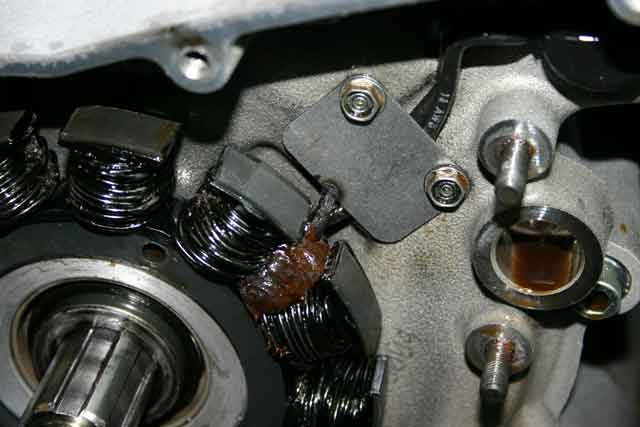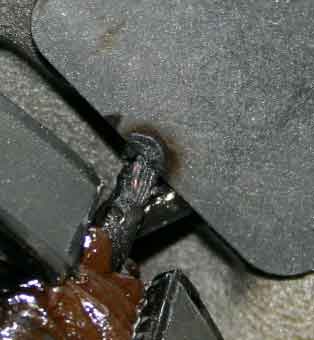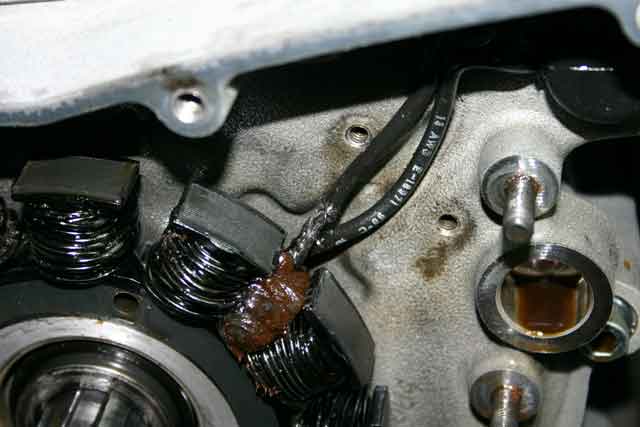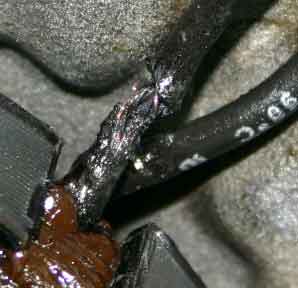| Author | Message | ||
Reepicheep |
This question has come up a few times, and I just had to fix it on my Cyclone, so I thought I would put together a simple how-to. This is a beta version, whack away at it and we can clean it up before making it a top level topic. Diagnosing electrical problems where the bike won't turn over. First the disclaimer. Your owners manual gives a great and highly detailed series of steps to find exactly what the problem is. It is more right then this is. But the manual has some complicated procedures to handle every case, and the vast majority of problems come down to one of five things. This is an attempt to capture a quick and simplified process to identify the three most common problems. If your engine won't turn over and start up, the problem should be one of five things. Your battery, your alternator, your voltage regulator, your starter relay, or your starter. This makes the assumption that the wiring is a part of each component. That is to say that the wires connected to the battery are considered part of the battery for this discussion. 1) Testing the battery. The battery must be able to both accept a charge and charge up, and deliver a charge to the starter. Put your dead battery on a trickle charger (or attach it to a car via jumper cables) for half an hour or so. You don't really want it fully topped off and charged, but rather you want it about half charged. If it then spins up freely (just with the lightly charged battery), the battery is probably fine, as is most of your wiring on that end of things. 2) If test one fails, it could be the starter, starter relay, or the battery. Disconnect your battery and try jumping the motorcycle off a car battery, or another known good bike battery. If it starts, the starter and starter relay are fine. If not, the starter or starter relay has a problem (or the engine is locked up, but that should be self evident). So by this point you should have either found the problem, or eliminated the battery, starter relay, or starter as the culprit. Even if you think you found the problem, you can do the next couple tests just to make sure everything makes sense. None take long or require much dissambly. 3) Start the bike (jump it, trickle charge it, bump start it, whatever) and keep it idling while throwing a DC meter across the battery terminals. Try to not have a fully topped off battery, but it would probably work regardless. You will burn your knuckles on the engine at least once during this step. Is the battery voltage getting higher, or lower? If the battery is charging, the voltage will slowly go up. If the battery is discharging, it will slowly go down. I had a pretty good meter (Fluke 77) and I could watch the battery drop about .01 volts every 20 seconds or so. Throw on the high beam to speed the process up. Revving the engine should bring up the battery voltage slightly as well. You probably are seeing the voltage drop. This just validates your previous conclusion that the problem is that the battery is not being recharged. This means that either the alternator is not producing current, or that the voltage regulator is not delivering current. 4) Disconnect the alternator wires outputs from the voltage regulator inputs. Follow the wires from the voltage regulator, there is a big rubber connector with cable ties around it tucked under the cam cover. You will probably need cut the cable ties holding it to the oil lines to get them apart. Measure the resistance between each pin on the wires coming from the stator (engine side) and ground. It should be really high (infinity). If it is low (mine read 5 ohms, toast), it is grounded and is toast. Also measure the resistence between the two pins (not pins to ground, which you did before, but pin to pin). This should be low, .2 to .4 ohms. Slap a meter set on AC volts across the two holes in the stator side of that connector you just pulled apart with the bike running (you will need a battery installed for this). You should see something like 30 to 50 volts AC. If you dont see it, either the alternator is dead, or the wiring between it and your connection has broken. If you do see enough volts AC, then the next piece of the puzzle left is the voltage regulator, and it is probably failing to regulate. Its a $98 part (GRRR) and probably only has a blown SCR (a $5 part) in it. Unfortunately it is a mondo PITA to get the potting out to get to that SCR. I can post a picture of about where the scr's are at though, so it may be possible to just drill down and do a surgical strike on those parts. This whole test procedure won't take long at all and has a pretty high chance of arriving at the right solution. Obviously, loose connections or internally broken wires could cause a part to look bad, but that stuff is pretty easy to check. These tests will at least help you know what sections to hunt. Batteries die most often. edited by reepicheep on April 02, 2004 edited by reepicheep on April 02, 2004 | ||
Reepicheep |
Please review the above first post for accuracy or enhancements. If it passes peer review, we can stick it in a more obvious place. I'll kick this new thread off with my latest gremlins. Very strange... My problems started with a bike that would not turn over. The battery was 5 years old, and was progressively getting weaker over months, so I just replaced it. I was lazy, I should have done a deeper diagnosis before fixing it. (cha-ching, $80) That seemed to work for a month or so, but I again found myself with a dead battery. I went through the above diagnostic procedure, saw 55 volts coming out my stator, but the voltage to the battery would not go up. So I replaced the voltage regulator. (cha-ching, $100) That worked for a week or so, and then I was right back where I started, and darned annoyed. Repeated above procedure, and now my stator output was only 5 volts AC. Grrr. Check resistance, sure enough I have a short to ground. Anybody else seen a cascading failure on these things like this? The original battery could have been good, but it was getting old anyway. I know something was up with the voltage regulator, the voltage to the battery would never go up with RPMS at all with the old reg, but with the new reg it would. Even if I somehow missed a decimal place on my first rotor output voltage check, and the stator was toast all along, I don't see how a grounded stator producing a net 5 volts AC could EVER produce up to 13 volts rising with RPMS at the battery. So the battery was probably un-necessary, but it seems really odd that I would loose a voltage regulator and a stator within weeks of each other. I will try and scare up a new stator today. I think I have pulled my primary cover more times in the last year then I have changed my oil  Also, anybody tried to get somebody to rewind these stators? Will somebody do that for $20 or so? If so, I may get it rewound and resell it... Also, anybody tried to get somebody to rewind these stators? Will somebody do that for $20 or so? If so, I may get it rewound and resell it... | ||
Bomber |
Reep -- a buddy suffered from the same ripple affect on his 97 S3 a couple of summers ago . . . . no theoretical reason I can conjure up (although I'm not nearly to your level of expertise) . . . . . rewinding services will rewind damn near anything (which is the only reason my much loved SR500 is still running), but the last time I had a bike stator rewound it was around 100 cash dollars american, and I got the impression I was getting a break, as the guy rode and liked my bike . . . I don't think rewinding is a cash-saving tactic any more, but, rather, a way to keep something on the road after the spares dry up or get way too pricey! | ||
Reepicheep |
Thanks bomber. Harley part is $123, aftermarket parts are $70. Nobody local stocks the aftermarket parts...  Sigh... | ||
Road_thing |
Reep: I had a cascading failure on the '73 FLH this week. First, the insulation on the battery cable wore through, causing a short to ground which, in addition to causing the starter to not work, provided a great spark & smoke show. $8.50 at O'Reilly (cha-ching...) Next, while replacing the battery cable I noticed that the terminal end of my starter solenoid was cracked (it's made of bakelite or some such) so I had to go to the stealership for a repair kit. $17.50 out the window (cha-ching...) Then, out of the blue, the starter relay gave up the ghost! Back to O'Reilly, there goes another $16.00(cha-ching...). I hope I have enough left for lunch...  r-t (gotta love those old shovels...) | ||
Newfie_buell |
My stator failed earlier this week and this is why? I did use Bill's diagnosis steps which summarized thing very well.     | ||
Newfie_buell |
You can clearly see where the plate holding the wires in place cut through the insulation causing the stator to go straight to ground. | ||
Reepicheep |
Glad the testing procedure was useful. In theory, that stator could probably be recovered, but the things seem to have a somewhat fixed lifespan anyway, so I would probably just replace it while I had stuff apart. Aftermarket parts were like half the price of the Harley parts, and are probably just as good (if not better). | ||
Reepicheep |
On second look, the windings at about 11:00 oclock on that picture above look like they are shorted and bubbling. | ||
Kdkerr2  |
Bikes need voltmeters. Without one you have no idea whether or not your charging system is working. Unfortunately the only Harleys stock equipped with them are Electra Glides. I've got aftermarket units on both my FXR and Beemer. The FXR is running a Norskog [not sure about the spelling]. It's a digital and so far it's been doing great. Of course you have to have a custom mount so unless you're a machinist forget it. The big problem with the Norskog is that it has two control levers on the face [it was designed for automotive use] and these need sealing with silicon or other adhesives to prevent rain from getting in. I now recommend Dakota Digital if you really must have a bike specific voltmeter which has no leaky holes in the face. Also if you are running this meter across the battery terminals [which is most accurate] then you need to fuse it with a 3-5 amp fuse. KK | ||
Al_lighton  |
All too common a failure. When I replaced my stator recently, I cleaned up the case real good around that plate and potted the wire in with RTV. IF the plate doesn't cut the wire, it still has the failure mode where the wire flexing causes it to fail where the stranded wire connects to the stator solid conductor windings. Hopefuly the potting will minimize the flexing. See here for a voltmeter solution that worked for me. Al |